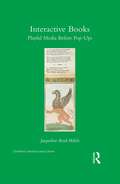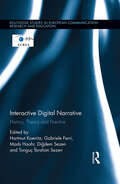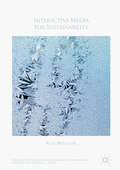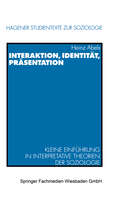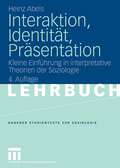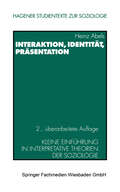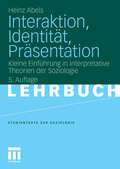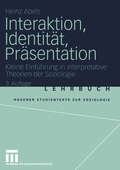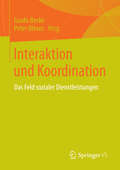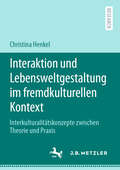- Table View
- List View
Interactive Books: Playful Media before Pop-Ups (Children's Literature and Culture)
by Jacqueline Reid-WalshMovable books are an innovative area of children’s publishing. Commonly equated with spectacular pop-ups, movable books have a little-known history as interactive, narrative media. Since they are hybrid artifacts consisting of words, images and movable components, they cross the borders between story, toy, and game. Interactive Books is a historical and comparative study of early movable books in relation to the children who engage with them. Jacqueline Reid-Walsh focuses on the period movable books became connected with children from the mid-17th to the early-19th centuries. In particular, she examines turn-up books, paper doll books, and related hybrid experiments like toy theaters and paignion (or domestic play set) produced between 1650 and 1830. Despite being popular in their own time, these artifacts are little known today. This study draws attention to a gap in our knowledge of children’s print culture by showing how these artifacts are important in their own right. Reid-Walsh combines archival research with children’s literature studies, book history, and juvenilia studies. By examining commercially produced and homemade examples, she explores the interrelations among children, interactive media, and historical participatory culture. By drawing on both Enlightenment thinkers and contemporary digital media theorists Interactive Books enables us to think critically about children’s media texts paper and digital, past and present.
Interactive Digital Narrative: History, Theory and Practice (Routledge Studies in European Communication Research and Education)
by Hartmut Koenitz Mads Haahr Gabriele Ferri Di 287 Dem Sezen Tonguç 304 Brahim SezenThe book is concerned with narrative in digital media that changes according to user input—Interactive Digital Narrative (IDN). It provides a broad overview of current issues and future directions in this multi-disciplinary field that includes humanities-based and computational perspectives. It assembles the voices of leading researchers and practitioners like Janet Murray, Marie-Laure Ryan, Scott Rettberg and Martin Rieser. In three sections, it covers history, theoretical perspectives and varieties of practice including narrative game design, with a special focus on changes in the power relationship between audience and author enabled by interactivity. After discussing the historical development of diverse forms, the book presents theoretical standpoints including a semiotic perspective, a proposal for a specific theoretical framework and an inquiry into the role of artificial intelligence. Finally, it analyses varieties of current practice from digital poetry to location-based applications, artistic experiments and expanded remakes of older narrative game titles.
Interactive Digital Narrative: History, Theory and Practice (Routledge Studies in European Communication Research and Education)
by Hartmut Koenitz Mads Haahr Gabriele Ferri Diğdem Sezen Tonguç İbrahim SezenThe book is concerned with narrative in digital media that changes according to user input—Interactive Digital Narrative (IDN). It provides a broad overview of current issues and future directions in this multi-disciplinary field that includes humanities-based and computational perspectives. It assembles the voices of leading researchers and practitioners like Janet Murray, Marie-Laure Ryan, Scott Rettberg and Martin Rieser. In three sections, it covers history, theoretical perspectives and varieties of practice including narrative game design, with a special focus on changes in the power relationship between audience and author enabled by interactivity. After discussing the historical development of diverse forms, the book presents theoretical standpoints including a semiotic perspective, a proposal for a specific theoretical framework and an inquiry into the role of artificial intelligence. Finally, it analyses varieties of current practice from digital poetry to location-based applications, artistic experiments and expanded remakes of older narrative game titles.
Interactive Documentary: Theory and Debate
by Kate NashTracing continuities in digital and documentary practices, this book is a study of interactive documentary from the perspective of documentary culture. Exploring the dizzying array of new documentary forms that have emerged in the past ten years, the book is grounded in the analysis of multiple recent examples of digital documentary work, drawing out the key issues that the work raises. These issues provide a starting point for theoretical reflection, with each chapter developing concepts and frameworks to facilitate thinking with and through interactive documentary. The book explores questions of polyvocality, participation, and political voice, as well as the sociality and performativity of digital documentary practice. By thinking deeply and critically about interactive documentary practice, the book charts the many and various ways in which interactive documentaries claim the real – contingently, partially, or, in some cases, collectively. Each chapter draws on a range of examples – from digital games to data visualisations, database documentaries to virtual reality – demonstrating how we might engage with these ‘unstable’ digital texts. The book will be particularly valuable for students and researchers keen to make connections between documentary and digital media scholarship.
Interactive Documentary: Theory and Debate
by Kate NashTracing continuities in digital and documentary practices, this book is a study of interactive documentary from the perspective of documentary culture. Exploring the dizzying array of new documentary forms that have emerged in the past ten years, the book is grounded in the analysis of multiple recent examples of digital documentary work, drawing out the key issues that the work raises. These issues provide a starting point for theoretical reflection, with each chapter developing concepts and frameworks to facilitate thinking with and through interactive documentary. The book explores questions of polyvocality, participation, and political voice, as well as the sociality and performativity of digital documentary practice. By thinking deeply and critically about interactive documentary practice, the book charts the many and various ways in which interactive documentaries claim the real – contingently, partially, or, in some cases, collectively. Each chapter draws on a range of examples – from digital games to data visualisations, database documentaries to virtual reality – demonstrating how we might engage with these ‘unstable’ digital texts. The book will be particularly valuable for students and researchers keen to make connections between documentary and digital media scholarship.
Interactive Documentary: Decolonizing Practice-Based Research
by Kathleen M. Ryan David StatonInteractive documentary is still an emerging field that eludes concise definitions or boundaries. Grounded in practice-based research, this collection seeks to expand the sometimes exclusionary field, giving voice to scholars and practitioners working outside the margins. Editors Kathleen M. Ryan and David Staton have curated a collection of chapters written by a global cohort of scholars to explore the ways that interactive documentary as a field of study reveals an even broader reach and definition of humanistic inquiry itself. The contributors included here highlight how emerging digital technologies, collaborative approaches to storytelling, and conceptualizations of practice as research facilitate a deeper engagement with the humanistic inquiry at the center of documentary storytelling, while at the same time providing agency and voice to groups typically excluded from positions of authority within documentary and practice-based research, as a whole. This collection represents a key contribution to the important, and vocal, debates within the field about how to avoid replicating colonial practices and privileging.This is an important book for practice-based researchers as well as advanced-level media and communication students studying documentary media practices, interactive storytelling, immersive media technologies, and digital methodologies.
Interactive Documentary: Decolonizing Practice-Based Research
by Kathleen M. Ryan David Staton Tammy Rae MatthewsInteractive documentary is still an emerging field that eludes concise definitions or boundaries. Grounded in practice-based research, this collection seeks to expand the sometimes exclusionary field, giving voice to scholars and practitioners working outside the margins. Editors Kathleen M. Ryan and David Staton have curated a collection of chapters written by a global cohort of scholars to explore the ways that interactive documentary as a field of study reveals an even broader reach and definition of humanistic inquiry itself. The contributors included here highlight how emerging digital technologies, collaborative approaches to storytelling, and conceptualizations of practice as research facilitate a deeper engagement with the humanistic inquiry at the center of documentary storytelling, while at the same time providing agency and voice to groups typically excluded from positions of authority within documentary and practice-based research, as a whole. This collection represents a key contribution to the important, and vocal, debates within the field about how to avoid replicating colonial practices and privileging.This is an important book for practice-based researchers as well as advanced-level media and communication students studying documentary media practices, interactive storytelling, immersive media technologies, and digital methodologies.
Interactive Exercises for the Police Recruit Assessment Process: Succeeding at Role Plays
by Jodi Roffey-Barentsen Peter Kennard Richard MalthouseThis book focuses on the Interactive Exercise, which forms a key part of the Police Recruit Assessment Process. The role play (as the exercise is often referred to) is traditionally the part of the recruitment test that candidates worry about most and find particularly difficult. The book clearly explains the role play process, making links to the Core Competencies and in particular examining issues of diversity. It offers a number of Interactive Exercises in the form of candidate and role player instructions and provides guidance on the completed exercises.
Interactive Exercises for the Police Recruit Assessment Process: Succeeding at Role Plays (PDF)
by Jodi Roffey-Barentsen Richard Malthouse Peter KennardThis book focuses on the Interactive Exercise, which forms a key part of the Police Recruit Assessment Process. The role play (as the exercise is often referred to) is traditionally the part of the recruitment test that candidates worry about most and find particularly difficult. The book clearly explains the role play process, making links to the Core Competencies and in particular examining issues of diversity. It offers a number of Interactive Exercises in the form of candidate and role player instructions and provides guidance on the completed exercises.
Interactive Experience in the Digital Age: Evaluating New Art Practice (Springer Series on Cultural Computing)
by Linda Candy Sam FergusonThe use of interactive technology in the arts has changed the audience from viewer to participant and in doing so is transforming the nature of experience. From visual and sound art to performance and gaming, the boundaries of what is possible for creation, curating, production and distribution are continually extending. As a consequence, we need to reconsider the way in which these practices are evaluated. Interactive Experience in the Digital Age explores diverse ways of creating and evaluating interactive digital art through the eyes of the practitioners who are embedding evaluation in their creative process as a way of revealing and enhancing their practice. It draws on research methods from other disciplines such as interaction design, human-computer interaction and practice-based research more generally and adapts them to develop new strategies and techniques for how we reflect upon and assess value in the creation and experience of interactive art. With contributions from artists, scientists, curators, entrepreneurs and designers engaged in the creative arts, this book is an invaluable resource for both researchers and practitioners, working in this emerging field.
Interactive Media for Sustainability (Palgrave Studies in Media and Environmental Communication)
by Roy BendorInteractive Media for Sustainability presents a conceptually rich, critical account of the design and use of interactive technologies to engage the public with sustainability. Treating interactive technologies as forms of mediation, the book argues that these technologies advance multiple understandings of sustainability. At stake are the ways sustainability encodes the complexity of interrelated social and natural systems, and how it conveys the malleability of the future. The book’s argument is anchored in a diverse set of theoretical resources that include contemporary work in human-computer interaction (HCI), social theory, media studies, and the philosophy of technology, and is animated by a variety of examples, including interactive simulations, persuasive apps, digital games, art installations, and decision-support tools.
Interactive Media for Sustainability (Palgrave Studies in Media and Environmental Communication)
by Roy BendorInteractive Media for Sustainability presents a conceptually rich, critical account of the design and use of interactive technologies to engage the public with sustainability. Treating interactive technologies as forms of mediation, the book argues that these technologies advance multiple understandings of sustainability. At stake are the ways sustainability encodes the complexity of interrelated social and natural systems, and how it conveys the malleability of the future. The book’s argument is anchored in a diverse set of theoretical resources that include contemporary work in human-computer interaction (HCI), social theory, media studies, and the philosophy of technology, and is animated by a variety of examples, including interactive simulations, persuasive apps, digital games, art installations, and decision-support tools.
Interactive Storytelling: Third Joint Conference on Interactive Digital Storytelling, ICIDS 2010, Edinburgh, UK, November 1-3, 2010, Proceedings (Lecture Notes in Computer Science #6432)
by Ruth Aylett Mei Yii Lim Sandy Louchart Paolo Petta Mark RiedlInteraktion, Identität, Präsentation: Kleine Einführung in interpretative Theorien der Soziologie (Hagener Studientexte zur Soziologie #1)
by Heinz AbelsDie vorliegende Einführung ist das Ergebnis einer Vorlesung, die in St. Petersburg gehalten wurde und in verständlicher Sprache mit einer damals relativ unbekannten soziologischen Diskussion vertraut machen sollte. Deshalb werden die wichtigsten Annahmen von George Herbert Mead zum Thema Identität und von Herbert Blumer zur symbolischen Interaktion dargestellt. Danach wird die phänomenologische Grundlegung der Soziologie durch Alfred Schütz nachgezeichnet, und es wird vor diesem Hintergrund die Theorie der gesellschaftlichen Konstruktion der Wirklichkeit von Peter L. Berger und Thomas Luckmann skizziert. Im letzten Teil wird zunächst die Ethnomethodologie nach Harold Garfinkel als eine Theorie des Handelns im Alltag vorgestellt, und dann werden aus den Arbeiten von Erving Goffman Techniken der Präsentation behandelt.
Interaktion, Identität, Präsentation: Kleine Einführung in interpretative Theorien der Soziologie (Studientexte zur Soziologie)
by Heinz AbelsDie Einführung macht in verständlicher Sprache mit interpretativen Theorien vertraut. Es werden die wichtigsten Annahmen von George Herbert Mead zum Thema Identität und von Herbert Blumer zur symbolischen Interaktion dargestellt. Anschließend wird die phänomenologische Grundlegung der Soziologie durch Alfred Schütz nachgezeichnet und vor diesem Hintergrund die Theorie der gesellschaftlichen Konstruktion der Wirklichkeit von Peter L. Berger und Thomas Luckmann skizziert. Im letzten Teil werden die Ethnomethodologie nach Harold Garfinkel als eine Theorie des Handelns im Alltag vorgestellt und aus den Arbeiten von Erving Goffman Techniken der Präsentation behandelt.
Interaktion, Identität, Präsentation: Kleine Einführung in interpretative Theorien der Soziologie (Studientexte zur Soziologie)
by Heinz AbelsDie vorliegende Einführung ist das Ergebnis einer Vorlesung, die in St. Petersburg gehalten wurde und in verständlicher Sprache mit einer damals relativ unbekannten soziologischen Diskussion vertraut machen sollte. Deshalb werden die wichtigsten Annahmen von George Herbert Mead zum Thema Identität und von Herbert Blumer zur symbolischen Interaktion dargestellt. Anschließend wird die phänomenologische Grundlegung der Soziologie durch Alfred Schütz nachgezeichnet und vor diesem Hintergrund die Theorie der gesellschaftlichen Konstruktion der Wirklichkeit von Peter L. Berger und Thomas Luckmann skizziert. Im letzten Teil wird die Ethnomethodologie nach Harold Garfinkel als eine Theorie des Handelns im Alltag vorgestellt und aus den Arbeiten von Erving Goffmann Techniken der Präsentation behandelt.
Interaktion, Identität, Präsentation: Kleine Einführung in interpretative Theorien der Soziologie (Studientexte zur Soziologie)
by Heinz AbelsDie Einführung macht in verständlicher Sprache mit interpretativen Theorien vertraut. Es werden die wichtigsten Annahmen von George Herbert Mead zum Thema Identität und von Herbert Blumer zur symbolischen Interaktion dargestellt. Anschließend wird die phänomenologische Grundlegung der Soziologie durch Alfred Schütz nachgezeichnet und vor diesem Hintergrund die Theorie der gesellschaftlichen Konstruktion der Wirklichkeit von Peter L. Berger und Thomas Luckmann skizziert. Im letzten Teil werden die Ethnomethodologie nach Harold Garfinkel als eine Theorie des Handelns im Alltag vorgestellt und aus den Arbeiten von Erving Goffman Techniken der Präsentation behandelt.
Interaktion, Identität, Präsentation: Kleine Einführung in interpretative Theorien der Soziologie (Studientexte zur Soziologie)
by Heinz AbelsDie Einführung macht in verständlicher Sprache mit interpretativen Theorien vertraut. Es werden die wichtigsten Annahmen von George Herbert Mead zum Thema Identität und von Herbert Blumer zur symbolischen Interaktion dargestellt. Anschließend wird die phänomenologische Grundlegung der Soziologie durch Alfred Schütz nachgezeichnet und vor diesem Hintergrund die Theorie der gesellschaftlichen Konstruktion der Wirklichkeit von Peter L. Berger und Thomas Luckmann skizziert. Im letzten Teil wird die Ethnomethodologie nach Harold Garfinkel als eine Theorie des Handelns im Alltag vorgestellt und aus den Arbeiten von Erving Goffmann Techniken der Präsentation behandelt.
Interaktion in pädagogischen Institutionen (Qualitative Sozialforschung #8)
by Sigrid NoldaErläutert wird der theoretische Hintergrund und die Methoden von Forschungen zur Interaktion in pädagogischen Institutionen. An einem Beispiel aus dem Bereich der Erwachsenenbildung werden die einzelnen Arbeitsschritte von derartigen Analysen und die damit verbundenen Probleme beschrieben.
Interaktion und Koordination: Das Feld sozialer Dienstleistungen
by Guido Becke Peter BlesesIn diesem Band wird die in der wissenschaftlichen Debatte bislang wenig beachtete Wechselbeziehung zwischen Interaktions- und Koordinationsarbeit am Beispiel sozialer Dienstleistungen beleuchtet: Koordinationsarbeit bildet beispielsweise eine wesentliche Voraussetzung für gelungene Interaktionsarbeit; Koordinationsarbeit beinhaltet selbst auch Interaktionsarbeit. Der Zusammenhang zwischen Interaktions- und Koordinationsarbeit wird in theoretisch-konzeptioneller Hinsicht und auf Basis empirischer Befunde aus verschiedenen Handlungsfeldern sozialer Dienstleistungen hin entfaltet. Auf dieser Grundlage werden Gestaltungsansätze für eine nachhaltige Arbeitsqualität von Interaktions- und Koordinationsarbeit sowie ein erweitertes Produktivitätsverständnis sozialer Dienstleistungen aufgezeigt.
Interaktion und Lebensweltgestaltung im fremdkulturellen Kontext: Interkulturalitätskonzepte zwischen Theorie und Praxis
by Christina HenkelDeutsche Studierende reisen in eine andere Lebenswelt, um Weltwissen zu erlangen. Wie diese Erfahrung verläuft und wie die Akteur*innen de-/ re-/ konstruierend ihre interkulturelle Kompetenz erwerben, steht im Zentrum dieser Forschung. Es wird untersucht, welche Bedeutung kulturelle und lebensweltliche Interaktionen bei der Konstruktion von Lebenswelt haben und welche Faktoren beziehungsweise Kategorien als Kompass für kulturelles Handeln und die Deutungsarbeit dienen. Vor dem Hintergrund eines Integrationsparadigmas wird der Frage nachgegangen, wie Kulturkontakte verlaufen und welche Qualitäten diese aus Perspektive der Akteur*innen haben.
Interaktion zwischen Spezies: Fremdheit und Nähe (Vital Turn: Leib, Körper, Emotionen)
by Anna K.E. SchneiderWie gestalten sich Mensch-Tier-Interaktionen? Anna Schneider nähert sich dieser Frage gestützt auf Theorien des Symbolischen Interaktionismus, der Philosophischen Anthropologie und Leibphänomenologie sowie verschiedenen Empathiekonzepten. Die Autorin erörtert hierfür ausführlich zwei Fallstudien zur Erkundung von Mensch-Tier-Interaktionen im privaten Umfeld (Mensch-Hund) und im institutionellen Rahmen einer Auffangstation (Mensch-Raubkatze). Sie stellt die speziesübergreifende Interaktion als dialektischen Prozess dar, welcher auf verschiedenen Ebenen vollzogen wird und entscheidend von den Faktoren der Annäherung und Abgrenzung zum Anderen geprägt ist. Die komplexe Methodik und hohe Interdisziplinarität der Arbeit verdeutlicht dabei den Bedarf an innovativen Forschungsmethoden für eine inklusive Mensch-Tier-Forschung und bietet einen theoretischen und methodischen Bezugsrahmen für zukünftige Forschung.
Interaktionen von Fußballfans: Das Spiel am Rande des Spiels
by Martin WinandsMartin Winands untersucht in einer ethnographischen Studie die Interaktionen von Fußballfans im Stadion und entwickelt eine eigene, gegenstandsgegründete Theorie der Interaktionsordnungen. Die Analysen werden maßgeblich von den theoretischen Ausführungen Goffmans beeinflusst, auf deren Basis ein sensibilisierendes Konzept entwickelt wird. Die grundlagenwissenschaftlich angelegte Forschung gibt Impulse für eine theoretisch wie empirisch fundierte Fansozialforschung und es werden analytische Angebote für die handlungsorientierte Fansozialarbeit vorgeschlagen. Die Analysen zeigen, dass die Ultragruppen im Zentrum der Interaktionen stehen und vielerorts die Stimmung in den Stadien von ihnen abhängig ist. Zudem werden autoritäre Muster sichtbar, da die Ultragruppen häufig darüber entscheiden, welche Artikulationen legitim sind und welche nicht.
Interaktionistischer Konstruktivismus: Zur Systemtheorie der Sozialisation
by Tilmann SutterIm Bereich der Gesellschaftsanalyse hat die neuere Systemtheorie wichtige Auseinandersetzungen ausgelöst. Die Frage, welche Beiträge die Systemtheorie für die Analyse von Sozialisation und Subjektbildung liefert, führt dagegen in ein noch kaum beschrittenes Neuland. Der Band geht dieser Frage nach und versucht dabei, bewährte strukturgenetische Sozialisationstheorien in Kontakt zu systemtheoretischen Sichtweisen zu bringen. Die in den Sozialisationstheorien vorzufindende Gegenüberstellung von subjektzentrierten und soziologischen Erklärungsansätzen kann aufgelöst werden, wenn mit der Systemtheorie die jeweils eigenständige Organisation subjektiver und sozialer Prozesse in Rechnung gestellt wird. Die Studien behandeln sowohl Prozesse der Entwicklung und Sozialisation als auch methodologische und methodische Fragen. Sie rücken so eine Theorie der Selbstsozialisation unter gewandelten Bedingungen gesellschaftlicher Differenzierung in den Mittelpunkt des Interesses.
Interaktionsordnungen: Gesundheit als soziale Praxis
by Andreas Hanses Kirsten SanderGesundheit wird, so die zentrale These des Sammelbandes, in den Interaktionsordnungen des Gesundheitssystems beständig verhandelt, ohne das die darin wirksam werdenden Wahrnehmungen und Zuschreibungen explizit gemacht werden. Sowohl in der Zusammenarbeit unterschiedlicher Gesundheitsberufe wie in den face-to-face Situationen zwischen den KlientInnen und den Professionellen werden Vorstellungen von Gesundheit und Professionalität erzeugt, in Handlung umgesetzt und/oder in Frage gestellt. In ihren Beiträgen entwickeln die Autorinnen und Autoren eine fundierte sozial- und erziehungswissenschaftliche Perspektive auf Gesundheit als soziale Praxis.
